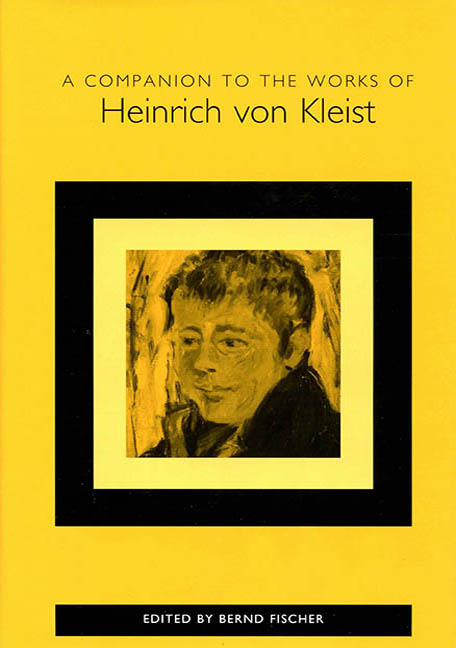Book contents
- Frontmatter
- Contents
- Introduction: Heinrich von Kleist's Life and Work
- Critical Approaches
- Language and Form
- Intellectual Paradigms
- Themes and Motifs
- Changing Color: Kleist's “Die Verlobung in St. Domingo” and the Discourses of Miscegenation
- Ripe Moments and False Climaxes: Thematic and Dramatic Configurations of the Theme of Death in Kleist's Works
- “Mein ist die Rache spricht der Herr”: Violence and Revenge in the Works of Heinrich von Kleist
- Notes on the Contributors
- Index
Changing Color: Kleist's “Die Verlobung in St. Domingo” and the Discourses of Miscegenation
from Themes and Motifs
Published online by Cambridge University Press: 27 April 2017
- Frontmatter
- Contents
- Introduction: Heinrich von Kleist's Life and Work
- Critical Approaches
- Language and Form
- Intellectual Paradigms
- Themes and Motifs
- Changing Color: Kleist's “Die Verlobung in St. Domingo” and the Discourses of Miscegenation
- Ripe Moments and False Climaxes: Thematic and Dramatic Configurations of the Theme of Death in Kleist's Works
- “Mein ist die Rache spricht der Herr”: Violence and Revenge in the Works of Heinrich von Kleist
- Notes on the Contributors
- Index
Summary
“Was kann ich, deren Vater aus St. Jago, von der Insel Cuba, war, für den Schimmer von Licht, der auf meinem Antlitz, wenn es Tag wird, erdämmert? Und was kann meine Tochter, die in Europa empfangen und geboren ist, dafür, daß der volle Tag jenes Weltteils von dem ihrigen widerscheint?” —
“Wie?” rief der Fremde. “Ihr, die Ihr nach Eurer ganzen Gesichtsbildung eine Mulattin und mithin afrikanischen Ursprungs seid, Ihr wäret samt der lieblichen jungen Mestize, die mir das Haus aufmachte, mit uns Europäern in einer Verdammnis?”
— Kleist, “Die Verlobung in St. Domingo”Mestizen: Mischlinge; Kinder, welche einen weißen europäischen Vater und eine schwarze amerikanische oder ostindische Mutter haben, oder auch umgekehrt. Die Ersten heißen gelbe, die Zweyten rothe Mestizen.
— Wörterbuch zur Erklärung fremder, aus andern Sprachen in die Deutsche aufgenommener Wörter und Redensarten. Ed. Conrad Schweizer, Zurich 1811Skin color and skin coloring, as even the most superficial reader will undoubtedly notice, play a key role in Kleist's novella “Die Verlobung in St. Domingo,” published in 1811, six years after the independence of the former French colony Saint-Domingue, now Haiti. Color divides the society on the island, as blacks murder whites in their all-out battle to overturn colonial rule. Shades of color cause confusion and undermine automatic allegiances. Whose side is Toni, with her “ins Gelbliche gehenden Gesichtsfarbe” (161), really on: her white fiancé Gustav's, or her black extended family's, represented by Babekan and Congo Hoango? Why does “yellow” fever not just destroy the European colonial troops but also serve in this story to define the insidious disease (in the eyes of the white narrator) the black woman is transmitting to the white man in the act of lovemaking/revenge? What does the tone red indicate — Gustav's blushing after admitting to his infatuation with Toni's black eyes (168), Toni's reddening after his suggestion that she might prefer a white man to her black suitor (173), and Toni's flushing with anger as Babekan is explaining her perfidious plan to murder whites? And why does Gustav change color when he perceives the mestiza Toni, as she enters the room with a black boy on her arm and handin-hand with a white man? Clearly, black, white, yellow, and red are central markers that hold the story together, drive the characters’ actions, create unions, and tear them apart.
- Type
- Chapter
- Information
- A Companion to the Works of Heinrich von Kleist , pp. 191 - 208Publisher: Boydell & BrewerPrint publication year: 2003



